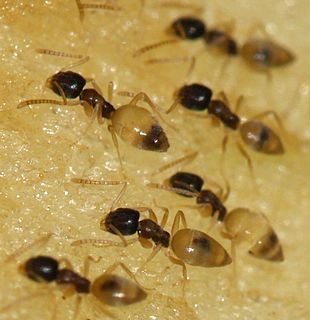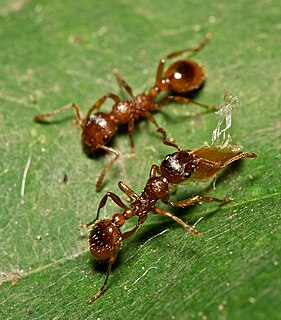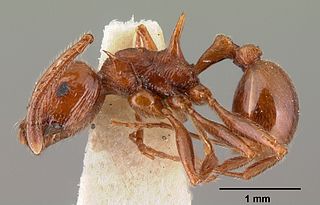
Tapinoma is a genus of ants that belongs to the subfamily Dolichoderinae. The genus currently comprises 74 described species distributed worldwide in tropical and temperate regions. Members of are generalized foragers, nesting in a wide variety of habitats, ranging from grasslands, open fields, woodlands, to inside buildings. The majority of species nest in the ground under objects such as stones or tree logs, other species build nests under bark of logs and stumps, in plant cavities, insect galls or refuse piles.

Myrmica is a genus of ants within the subfamily Myrmicinae. It is widespread throughout the temperate regions of the Holarctic and high mountains in Southeast Asia.

Aenictus is a large army ant genus distributed in the Old World tropics and subtropics. It contains about 181 species, making it one of the larger ant genera of the world.

Acromyrmex heyeri is a species of leaf-cutter ant, a New World ant of the subfamily Myrmicinae of the genus Acromyrmex.

Cerapachys is a genus of ants in the subfamily Dorylinae. Species are mainly myrmecophagous ants which raid the nests of other ants for prey. The genus is distributed widely throughout the Indomalayan region. The genus was revised by BoroWiec (2016) who split a number of previously synonymized genera out of Cerapachys, leaving only 5 species in the genus.

Stenamma is a genus of cryptic leaf-litter ants that occurs in mesic forest habitats throughout the Holarctic region, Central America, and part of northwestern South America.

Carebara is a genus of ants in the subfamily Myrmicinae. It is one of the largest myrmicine genera with more than 200 species distributed worldwide in the tropics and the Afrotropical region. Many of them are very tiny cryptic soil and leaf litter inhabitants. They nest in rotten wood to which the bark is still adherent in the Afrotropical region, or may be lestobiotic nesting near other ant species. Some species are known to exist parasitically within termite nests. Little is known about the biology of the species. However, they are notable for the vast difference in size between queens and workers.

Pristomyrmex is a genus of ants in the subfamily Myrmicinae.
Stenamma andersoni is a Neotropical species of ant in the subfamily Myrmicinae.
Aenictus gutianshanensis is a Chinese species of army ant in the genus Aenictus. The species is known only from a single colony. Little is known about its biology, but it is probably most closely related to A. vieti.
Oxyepoecus bidentatus is a Neotropical species of ant in the genus Oxyepoecus. The species is only known from workers from Paraguay.

Chrysapace is a genus of ants in the subfamily Dorylinae containing four described species. The genus is distributed across the Malaysian peninsula, Indonesia, and the Philippines, with undescribed species from Madagascar and from Baltic amber Chrysapace was described by Crawley (1924) and later placed as a junior synonym of Cerapachys by Brown (1975). Chrysapace was resurrected as a valid genus by Borowiec (2016) during redescription of the doryline genera.

Lioponera is a genus of ants in the subfamily Dorylinae containing approximately 74 described species. The genus is distributed widely across the Afrotropical, Australasia, Indomalaya, Malagasy, and Palearctic bioregions. Lioponera was described by Mayr (1879) and later placed as a junior synonym of Cerapachys by Brown (1975). Lioponera was resurrected as a valid genus by Borowiec (2016) during redescription of the doryline genera.

Ooceraea is a genus of ants in the subfamily Dorylinae containing approximately 16 described species. The genus is distributed across the Australasia, Indomalaya, Malagasy, Neotropical, Oceania, and Palearctic bioregions. Ooceraea was described by Roger (1862) and later placed as a junior synonym of Cerapachys by Brown (1973). Ooceraea was resurrected as a valid genus by Borowiec (2016) during redescription of the doryline genera.

Parasyscia is a genus of ants in the subfamily Dorylinae containing approximately 50 described species. The genus is distributed across the Afrotropical, Australasia, Indomalaya, Malagasy, Oceania, and Palearctic bioregions. Parasyscia was described by Emery (1882), moved to a subgenus of Cerapachys by Forel (1892) and finally placed as a junior synonym of Cerapachys by Kempf (1972). Parasyscia was resurrected as a valid genus by Borowiec (2016) during redescription of the doryline genera.
This list of fossil arthropods described in 2009 is a list of new taxa of trilobites, fossil insects, crustaceans, arachnids and other fossil arthropods that have been described during the year 2009, as well as other significant discoveries and events related to arthropod paleontology that occurred.

Trachymyrmex nogalensis is a species of higher myrmicine in the family Formicidae.

Camponotus quercicola is a species of ant in the family Formicidae that is endemic to California and commonly nests in oak trees, as they usually inhabit oak forests.














